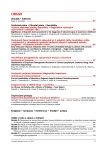n 18-year old Female with a History of Collapse – Case Report
Authors:
J. Minařík; M. Skácelová; P. Horák; A. Smržová; L. Faltýnek; V. Ščudla
Authors‘ workplace:
III. interní klinika – nefrologická, revmatologická a endokrinologická, FN a LF UP v Olomouci
Published in:
Transfuze Hematol. dnes,18, 2012, No. 2, p. 81-84.
Category:
Comprehensive Reports, Original Papers, Case Reports
Overview
The aim of this paper is to report a less frequent cause of collapse associated with minimal clinical symptoms in an 18-year old female. Laboratory examinations revealed severe macrocytic anaemia (Hb 35 g/l, MCV 114 fl) with mild alteration of biochemical parameters. The differential diagnosis focused on a possible malabsorption syndrome, which was finally confirmed in the form of celiac disease. Dietary measures as well as substitution therapy lead to rapid normalization of laboratory parameters and an improvement in the patient´s clinical condition. The aim of our paper is to draw attention to less frequent manifestations of celiac disease and to possible pitfalls of routine differential diagnosis of anaemia.
Key words:
macrocytic anaemia, malabsorption syndrome, collapse, celiac disease
Sources
1. Kagnoff MF. Celiac disease. A gastrointestinal disease with environmental, genetic, and immunologic components. Gastroenterol Clin North Am 1992; 21 : 405–425.
2. Schuppan D. Current concepts of celiac disease pathogenesis. Gastroenterology 2000; 119 : 234–242.
3. Fasano A. Where have all the American celiacs gone? Acta Paediatr Suppl 1996; 412 : 20-24.
4. Ferguson A, Arranz E, O’Mahony S. Clinical and pathological spectrum of coeliac disease-active, silent, latent, potential. Gut 1993; 34 : 150–151.
5. Stenson WF, Newberry R, Lorenz R, et al. Increased prevalence of celiac disease and need for routine screening among patients with osteoporosis. Arch Intern Med 2005; 165 : 393–399.
6. Holmes GK. Non-malignant complications of coeliac disease. Acta Paediatr Suppl 1996; 412 : 68–75.
7. Rampertab SD, Pooran N, Brar P, et al. Trends in the presentation of celiac disease. Am J Med 2006; 119 : 355.e9–14.
8. Collin P, Reunala T, Rasmussen M, et al. High incidence and prevalence of adult coeliac disease. Augmented diagnostic approach. Scand J Gastroenterol 1997; 32 : 1129–1133.
9. Schuppan D, Hahn EG. Celiac disease and its link to type 1 diabetes mellitus. J Pediatr Endocrinol Metab 2001; 14 Suppl 1 : 597–605.
10. Meini A, Pillan NM, Villanacci V, et al. Prevalence and diagnosis of celiac disease in IgA-deficient children. Ann Allergy Asthma Immunol 1996; 77 : 333–336.
11. Gale L, Wimalaratna H, Brotodiharjo A, Duggan JM. Down’s syndrome is strongly associated with coeliac disease. Gut 1997; 40 : 492–496.
12. Sainsbury A, Sanders DS, Ford AC. Meta-analysis: Coeliac disease and hypertransaminasaemia. Aliment Pharmacol Ther 2011; 34 : 33–40.
13. Counsell CE, Taha A, Ruddell WS. Coeliac disease and autoimmune thyroid disease. Gut 1994; 35 : 844-846.
14. Breen EG, Coghlan G, Connolly EC, et al. Increased association of ulcerative colitis and coeliac disease. Ir J Med Sci 1987; 156 : 120–121.
Labels
Haematology Internal medicine Clinical oncologyArticle was published in
Transfusion and Haematology Today

2012 Issue 2
Most read in this issue
- Current possibilities of laboratory diagnosis heparin-induced trombocytopenia
- n 18-year old Female with a History of Collapse – Case Report
- Significance of hepcidin level assessment in the diagnosis of selected types of anaemia in childhood
- Early molecular response evaluation after 3 months of imatinib therapy in patients with chronic myeloid leukemia can contribute to estimation of prognosis – single centre experience
